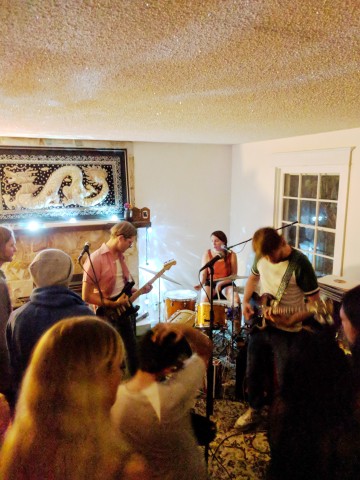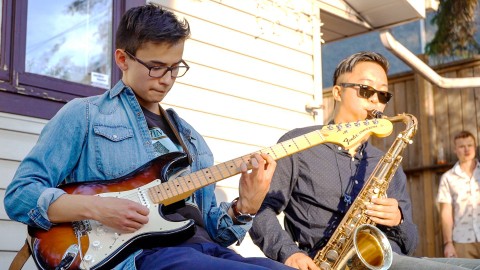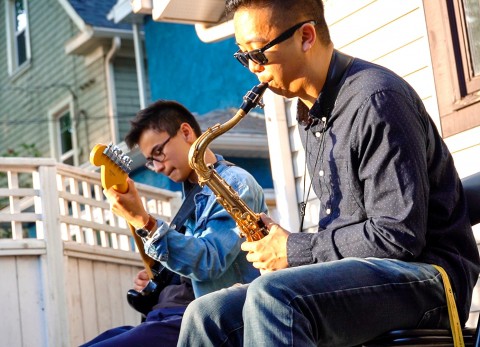For independent artists and their fans, traditional commercial venues can often be cost prohibitive, with expensive fees for performers and annoying cover charges for audiences. Through house shows, indie scenes across the country have taken the focus away from profits and redirected it towards art and community.
Concerts hosted in people’s homes have recently seen a rise in popularity in Saskatoon, with non-commercial venues like Witch Mansion frequently hosting local and out-of-town artists. Inspired by the more established local home venues, others have begun turning their living rooms and basements into pop-up performance spaces.
There’s something inexplicable about the sense of community felt at a house show. There’s a feeling that everyone involved — from the organizers to the audience to even the artists — is a fan of the local music scene above all else. The usual hierarchy of the bar or arena show, where bands and fans are separated by an invisible wall, seems to disappear.
I was fortunate enough to attend a house-show fundraiser this summer for Take Something and Run, a local non-profit organization that looks to expand the music scene in Saskatoon — bringing up the next generation of artists by funding monthly all-ages showcases.
TSAR put on a marathon-session concert, verging on the five-hour mark. Local songwriters — almost all of whom were either University of Saskatchewan students or young people who live and work in Saskatoon — crafted sets from original songs, covers and half-finished material. The experience completely sold me on house shows, and I’ve been hooked ever since.

The band Human Music, from Winnipeg, performs at a house show. | Ahren Klaassen-Wright
House shows aren’t a recent phenomenon. The history of the house show and the rise of independent music are inextricably linked. In the pre-Grunge era of independent music, the support of a larger community and the do-it-yourself spirit of punk music were the reasons that many legendary bands were able to continue touring through tough financial situations.
Michael Azerrad’s genealogy of the ’80s punk scene, Our Band Could Be Your Life, follows bands including Mission of Burma, Dinosaur Jr. and Sonic Youth through their indie-label years. Azerrad’s history of the scene is one of dingy tour vans, basement lodgings in strange cities, fan-made zines and all-ages venues.
In his book, Azerrad argues that community is the driving force of creativity. It’s hard to imagine the bands that Azerrad writes about being able to follow their creative ambitions if not for a vast network of supports built around a love of music. House shows, as they currently exist, are rooted in this tradition of shared experience and appreciation of art.
Classic post-hardcore band Fugazi created an entire ethos around unconventional venues. The band built their career on five-dollar shows held in empty car parks, school gymnasiums, community centres, churches, punk clubs and anywhere else that would accommodate them. One of those venues included Saskatoon’s own infamous punk dive Sid’s Garage.
As cited in Azerrad’s book, Fugazi frontman Guy Picciotto sums up the philosophy behind the modern house show perfectly:
“You find the Elks Lodge, you find the guy who’s got a space in the back of his pizzeria, you find the guy who has a gallery. Kids will do that stuff because they want to make stuff happen.”

Justice Der plays guitar and Eric Wong plays tenor sax while performing at a NOM outdoor house show. | Kyler Tesch
Saskatoon’s now legendary grindcore scene was presumably influenced by Fugazi’s DIY ethic, turning rental spaces like the upper Memorial Union Building — which currently houses Louis’ Loft — and Le Relais — an event space facilitated by the Fédération des Francophones de Saskatoon — into mosh pits.
The end of Saskatoon’s punk golden age saw the city’s independent scene push further underground, shifting its focus to house venues. This created a tightly knit DIY scene in Saskatoon.
Mackenzie Paradzik, a fifth-year arts and science student who has attended house shows in the past, speaks fondly about the first DIY show she attended.
“This was probably like 2015 or 2016, but it was in a house on Cumberland, and I just ended up there. I didn’t plan to end up there — I was out with friends, and I got dragged to what ended up being a house show,” Paradzik said.
Paradzik doesn’t remember the name of the band that played that night, but she says, “They played their music off of Nintendos, and they all wore these grass masks, and they had this weird lightshow in the basement — I just remember walking downstairs and being so confused because I didn’t even know that house shows were even a thing.”
The band in question was Saskatoon’s own electronic-music enigmas 3 Ninjasks who recently released their full-length album Zoams through the Toronto-based record label Adhesive Sounds. In the past year, the band has become a touring act and opened for electronic-pop artist Chad Valley at Amigos Cantina.
In the case of the Ninjasks and many other local artists, house shows have become a much-needed incubator for emerging talent. House shows offer an inexpensive venue and a safe environment where musicians can learn from failure without judgement, hone their stage presence and workshop new songs.

Wong and Der at a NOM outdoor house show. | Kyler Tesch
House shows may offer a lot for artists, but for those interested in running a venue in their home, there are many challenges associated with hosting house shows to keep in mind.
Duncan Pickard, who runs Witch Mansion and plays in the dream-pop band Shirley & The Pyramids identifies some of the obstacles associated with running a DIY venue.
“There are lots of challenges in hosting house shows. The obvious one is keeping noise at a reasonable level, so that you don’t bug the neighbours. The hardest part about that is keeping people quiet when they are outside,” Pickard said, in an email to the Sheaf. “Another challenge is making sure that people feel safe and comfortable… We try to make sure everyone is being respectful.”
When it comes to the legality of house shows, Pickard says, “Currently, [house shows are] a bit of a grey area. The legality of the shows depends on a range of factors, including if the show is public or private and if you charge cover or collect donations.”
As to whether or not the lack of regulation associated with DIY venues is something for attendees to be concerned about, Paradzik says she would be no more worried about the safety of house shows than she would be about the safety of any other venue.
“Personally, I’ve felt safer and more comfortable at house shows than I’ve probably felt at most shows I’ve been to at bars,” Paradzik said. “I feel like there’s a lot of focus on making house shows safe.”
With regards to the costs associated with running a venue like Witch Mansion, Pickard cites property damage as the main source of financial loss.
“Every so often, things go missing or get damaged, and it can really add up,” Pickard said.
Despite all of the costs and challenges that come with hosting live music in your living space, Pickard believes in the communal experience the scene evokes.
“DIY venues are more likely to be [run] for the love of music, and I think that is something that is felt by bands and fans. Being in a setting that isn’t a bar [means] less pressure for people to spend money throughout the night.”
Pickard is optimistic about the future of the scene as well.
“There is a shift going on across the country towards more house shows. It is hard to predict the future, but I hope that the scene will continue to develop, to build community between musicians and fans, young and old,” Pickard said.
Recently, DIY shows in Saskatoon have been instrumental in growing the local indie-music scene by creating a network of inexpensive and independent venues. The presence of this fascinating alternative to commercial venues is allowing fans and artists to build a community together.
—
Cole Chretien / Culture Editor
Photos: Ahren Klaassen-Wright, Kyler Tesch